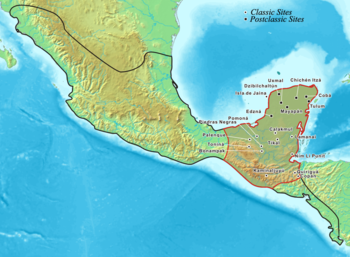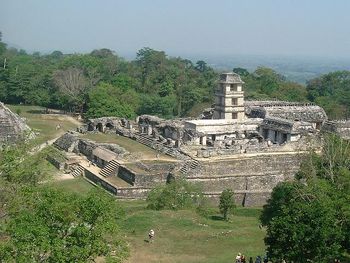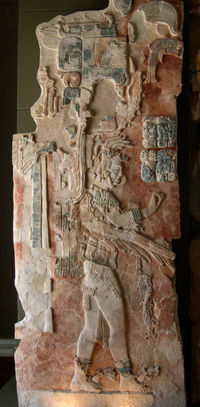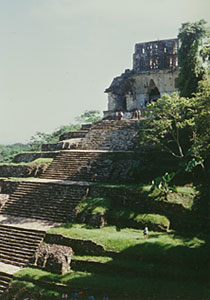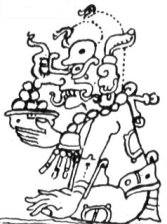Maya civilization
2007 Schools Wikipedia Selection. Related subjects: Ancient History, Classical History and Mythology
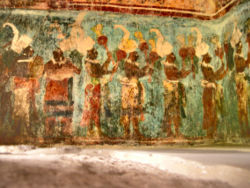 |
| Maya civilization |
|
Maya architecture |
| Maya history |
| Spanish conquest of Yucatán |
The Maya civilization is a Mesoamerican civilization, noted for the only known fully developed written language of the pre-Columbian Americas, as well as its spectacular art, monumental architecture, and sophisticated mathematical and astronomical systems. Many of these reached high development during the Classic period (ca. 250 C.E. to 900 C.E.), however these advances were also in the Preclassic (or Formative) period which came before, and in the Postclassic period which followed. At its peak, it was one of the most densely populated and culturally dynamic societies in the world. The area of the Maya civilization extended throughout the northern Central American region, including the present-day nations of Guatemala, Belize, western Honduras and El Salvador, as well as the southern Mexican states of Chiapas, Tabasco, and the Yucatán Peninsula states of Quintana Roo, Campeche and Yucatán.
The Maya civilization shares many features with other Mesoamerican civilizations, because there was a high degree of interaction and cultural diffusion throughout the region. Advances such as writing and the calendar did not originate with the Maya, however their civilization fully developed them. Maya influence can be detected as far as central Mexico, more than 1000 km (625 miles) from the Maya homeland. Many outside influences are found in Maya art and architecture, thought to be mainly a result of trade and cultural exchange, rather than direct external conquest.
The Maya peoples never disappeared, neither at the time of the Classic period decline nor with the arrival of the Spanish conquistadores and the subsequent Spanish colonization of the Americas. The Maya remain in contemporary Mesoamerican societies, and maintain a distinctive set of traditions and beliefs, combined with more recent practices such as the almost total adoption of Roman Catholicism. The Maya and their descendants form sizeable populations throughout the region formerly occupied by the states of the ancient civilization. Many different Mayan languages continue to be spoken as the primary language.
History
Preclassic
What would become the Maya region had been inhabited since at least the 10th millennium BC. Settled villages along the Pacific coast appear from 1800 BC, which is taken as the beginning of the Maya Early Preclassic era.
Some archaeological evidence shows the Maya had started to build ceremonial architecture by approximately 1000 BC and by the period known as the mid-Preclassic (or mid-Formative), around 600 BC, some of the earliest Maya complexes had been constructed. The earliest monuments consist of simple burial mounds, the precursors to pyramids erected in later times.
There is some disagreement about the boundaries which differentiate the physical and cultural extent of the early Maya and their neighboring Preclassic Mesoamerican civilizations, such as the Olmec culture of the Tabasco lowlands and the Mixe-Zoque– and Zapotec–speaking peoples of Chiapas and southern Oaxaca. Many of the earliest significant inscriptions and buildings appeared in this overlapping zone, and evidence suggests that these cultures and the formative Maya influenced one another. Eventually, the Olmec influence faded after spreading into the Yucatan peninsula, present-day Guatemala, and other regions.
Classic
The later Classic period (c. 250 - 900) witnessed the peak of widespread urban centre construction and the recording of monumental inscriptions, particularly in the southern lowland regions. They developed an agriculturally intensive, city-centered empire consisting of numerous independent city-states. This includes the famed cities of Tikal, Palenque, Copán and Kalakmul, as well as Dos Pilas, Uaxactun, Altun Ha, Bonampak and many other sites in the region (see list of sites, below).
The most notable monuments are the pyramids they built in their religious centers and the accompanying palaces of their rulers. Other important archaeological remains include the carved stone slabs usually called stelae (the Maya called them Tetun, or "Tree-stones"), which depict rulers along with hieroglyphic texts describing their genealogy, war victories, and other accomplishments.
The Maya participated in long distance trade in Mesoamerica and possibly further lands. Important trade goods included cacao, salt, and obsidian; see also: Obsidian use in Mesoamerica. Mayan lighthouse sites have been identified.
Collapse and Postclassic Period
For reasons which are still much debated, in the 8th and 9th centuries AD (the "Terminal Classic" period) Maya culture went into decline, with most of the cities of the central lowlands abandoned. Detailed monumental inscriptions all but disappeared. Although there is no universally accepted theory to explain Mayan decline, current theories fall into two categories: non-ecological and ecological. Non-ecological theories of Mayan decline are divided into several subcategories, such as foreign invasion, peasant revolt, the collapse of key trade routes, catastrophe, epidemic disease and climate change.
The archaeological evidence of the Toltec intrusion into Yucatan in Seibal supports the theory of foreign invasion. But most Mayanists don’t believe the foreign invasion as the main cause of the collapse; they postulate that no one military defeat can explain or be the cause of the protracted and complex Classic collapse process.
Archaeological evidence reveals that Maya building projects and expansion was at its peak from 730 to 790 A.D., with constant enlargement and building the majority of the burden was placed on peasant workers in the cities. It is believed that the Mayan people were generally selfless who would put forth hours of work for the betterment of the government. As life became more burdensome, work began to undermine the religious development and collective enterprise of ordinary people. For it was the strength of Mayan religions that historians believe allowed the Mayans to build such great monuments and temples. The increased burden of work is what many believe caused Mayan people to abandon their values and revolt against the elite of society. This would explain the abrupt collapse of elite functions as well as unfinished buildings, and ceremonial centers. Peasant revolt also explains the evidence of the burning of temples and smashing of thrones. It is believed that once the elite lost ceremonial centers they no longer had the power to sway people with religion through demonstrations and sacrifices. Peasant revolts throughout the empire would have happened slowly and at different times, which explains the gradual decay of Maya culture and power from 750 and 1050 A.D. However, even though the internal revolt theory may be convincing, it still has its flaws, most notably the idea that Mayan ideology was so strong that people would have never abandoned their religious views to overthrow the empire.
It is also possible that the decay of the Mayans is related to the collapse of their intricate trade systems, especially those connected to the northern city of Teotihuacán. Teotihuacán abruptly declined around 700 and 750 A.D., the fall of this city is believed to have contributed to the sudden change in Mayan economic and trade functions in the highlands, which resulted in a ripple effect of decline across the entire empire. Mayan kings relied heavily on tribute from the city of Teotihuacán as essential to their dominance and control of subjects. It is also believed that as cities grew in the late classic, 250-900 A.D., and post classic, 700-800 A.D., periods, they could no longer sustain themselves and were forced to become more specialized. As cities became more specialized they relied more heavily on trade. However, Mayans were not equipped to handle trade at such a magnitude because the absence of the wheel made it difficult to move heavy amounts of goods from one place to another.
The catastrophic event theory focuses on one or more natural disasters, such as earthquakes, hurricanes and volcanic eruptions, as the cause of the collapse of the Mayans. However, the lack of archaeological evidence makes it unlikely that a single natural disaster caused the long collapse. At the same time, several successive natural disasters, each of less than catastrophic proportions, might have caused the collapse.
The disease theory is also a contender for explaining the Mayan collapse. Widespread disease could explain the rapid depopulation of the classic Maya civilization and the lack of recovery over the long run. But the difficulty of getting archaeological evidence makes this theory not universally accepted.
A still further theory is that rapid climate change and severe drought contributed to the Classic collapse, based on the evidence of the Lake Chichancanab. This evidence, found in shells recovered from Lake Chichancanab (in modern Quintana Roo state in Mexico) by a team from the University of Florida, suggests that the area suffered the worst drought in 7,000 years in the 9th century. This evidence seems to support the theory that an unusually severe drought leading to a catastrophic decimation of the population was the driving force behind the collapse of Maya civilization
The ecological theories of Mayan decline usually focus on the worsening relationship between Mayan civilization and agricultural conditions in the late classic period. The archaeological evidence has shown that the Mayans’ agriculture was dependent on a simple slash-and-burn system. Based on it, the hypothesis of Soil Exhaustion was advanced by O.F. Cook in 1921. Similar assumptions are erosion and intensive agricultural and Savanna grass competition.
However, despite a substantial number of possible causes, there is no single cause universally accepted for this lengthy decline.
During the succeeding Postclassic period (from the 9th to the early 16th century), development in the northern centers persisted, characterised by an increasing diversity of external influences. The Maya cities of the northern lowlands in Yucatan continued to flourish for centuries more; some of the important sites in this era were Chichen Itza, Uxmal, Edzná, and Coba. After the decline of the ruling dynasties of Chichen and Uxmal, Mayapan ruled all of Yucatan until a revolt in 1450. The area then devolved into city states until the Yucatán was conquered by the Spanish.
The Itza Maya, Kowoj and Yalain groups of Central Peten survived the "Classic Period Collapse" in small numbers and by AD 1250 reconstituted themselves to form competing city-states. The Itza kingdom had its capital at Noj Peten, an archaeological site thought to underlay modern day Flores, Guatemala. It ruled over an area extending across the Peten Lakes region, encompassing the community of Eckixil on Lake Quexil. These sites and this region were inhabited continuously by independent Maya until after the final Spanish Conquest of 1697 AD.
Postclassic Maya states also continued to survive in the southern highlands. One of the Maya kingdoms in this area, the Quiché, is responsible for the best-known Maya work of historiography and mythology, the Popol Vuh.
However by the time of the Spanish arrival in 1519 it is generally accepted that most of these centers had substantively declined from their Classical peak.
Colonial period
Shortly after their first expeditions to the region, the Spanish initiated a number of attempts to subjugate the Maya and establish a colonial presence in the Maya territories of the Yucatán Peninsula and the Guatemalan highlands. This campaign, sometimes termed "The Spanish Conquest of Yucatán", would prove to be a lengthy and fraught exercise for the conquistadores from the outset, and it would take some 170 years before the Spanish established substantive control over all Maya lands.
Unlike the Spanish campaigns against the Aztec and Inca Empires, there was no single Maya political centre which once overthrown would hasten the end of collective resistance from the indigenous peoples. Instead, the conquistador forces needed to subdue the numerous independent Maya polities almost one by one, many of which kept up a fierce resistance. Most of the conquistadores were motivated by the prospects of the great wealth to be had from the seizure of precious metal resources such as gold or silver, however the Maya lands themselves were poor in these resources. This would become another factor in forestalling Spanish designs of conquest, as they instead were initially attracted to the reports of great riches in central Mexico or Peru.
The last Maya state, the Itza polity of Tayasal at Lake Petén Itzá, was not subdued by Spanish authorities until 1697.
Political structures
A typical Classic Maya polity was a small hierarchical state (ajawil, ajawlel, ajawlil) headed by a hereditary ruler – ajaw, later k’uhul ajaw. Such kingdoms were usually no more than a capital city with its neighbourhood and several lesser towns, although there were greater kingdoms, which controlled larger territories and extended patronage over smaller polities.
Each kingdom had a name that did not necessarily correspond to any locality within its territory. Its identity was that of a political unit associated with a particular ruling dynasty. For instance, the archaeological site of Naranjo was the capital of the kingdom of Saal. The land (chan ch’e’n) of the kingdom and its capital were called Wakab’nal or Maxam and were part of a larger geographical entity known as Huk Tsuk. Interestingly, despite constant warfare and eventual shifts in regional power, most kingdoms never disappeared from the political landscape until the collapse of the whole system in the 9th century AD. In this respect, Classic Maya kingdoms are highly similar to late Post Classic polities encountered by the Spaniards in Yucatan and Central Mexico: some polities could be subordinated to hegemonic rulers through conquests or dynastic unions and yet even then they persisted as distinct entities.
Mayanists have been increasingly accepting a "court paradigm" of Classic Maya societies which puts the emphasis on the centrality of the royal household and especially the person of the king. This approach focuses on Maya monumental spaces as the embodiment of the diverse activities of the royal household. It considers the role of places and spaces (including dwellings of royalty and nobles, throne rooms, temples, halls and plazas for public ceremonies) in establishing power and social hierarchy, and also in projecting aesthetic and moral values to define the wider social realm.
Spanish sources invariably describe even the largest Maya settlements as dispersed collections of dwellings grouped around the temples and palaces of the ruling dynasty and lesser nobles. None of the Classic Maya cities shows evidence of economic specialization and commerce of the scale of Mexican Tenochtitlan. Instead, Maya cities could be seen as enormous royal households, the locales of the administrative and ritual activities of the royal court. They were the places where privileged nobles could approach the holy ruler, where aesthetic values of the high culture were formulated and disseminated, where aesthetic items were consumed. They were the self-proclaimed centers and the sources of social, moral, and cosmic order. The fall of a royal court as in the well-documented cases of Piedras Negras or Copan would cause the inevitable "death" of the associated settlement.
Art
Many consider Maya art of their Classic Era (c. 200 to 900 AD) to be the most sophisticated and beautiful of the ancient New World. The carvings and stucco reliefs at Palenque and the statuary of Copán are especially fine, showing a grace and accurate observation of the human form that reminded early archaeologists of Classical civilization of the Old World, hence the name bestowed on this era. We have only hints of the advanced painting of the classic Maya; mostly what have survived are funerary pottery and other Maya ceramics. Also a building at Bonampak holds ancient murals that survived by serendipity. With the decipherment of the Maya script it was discovered that the Maya were one of the few civilizations where artists attached their name to their work.
Architecture
As unique and spectacular as Greek or Roman architecture, Maya architecture spans many thousands of years; yet, often the most dramatic and easily recognizable as Maya are the fantastic stepped pyramids from the Terminal Pre-classic period and beyond.
There are also cave sites that are important to the Maya. These cave sites include Jolja Cave, the cave site at Naj Tunich, the Candelaria Caves, and the Cave of the Witch. There are also cave- origin myths among the Maya. Some cave sites are still used by the modern Maya in the Chiapas highlands.
It has been suggested that, in conjunction to the Maya Long Count Calendar, every fifty-two years, or cycle, temples and pyramids were remodeled and rebuilt. It appears now that the rebuilding process was often instigated by a new ruler or for political matters, as opposed to matching the calendar cycle. However, the process of rebuilding on top of old structures is indeed a common one. Most notably, the North Acropolis at Tikal seems to be the sum total of 1,500 years of architectural modifications.
Through observation of the numerous consistent elements and stylistic distinctions, remnants of Maya architecture have become an important key to understanding the evolution of their ancient civilization.
Urban design
As Maya cities spread throughout the varied geography of Mesoamerica, site planning appears to have been minimal. Maya architecture tended to integrate a great degree of natural features, and their cities were built somewhat haphazardly as dictated by the topography of each independent location. For instance, some cities on the flat limestone plains of the northern Yucatan grew into great sprawling municipalities, while others built in the hills of Usumacinta utilized the natural loft of the topography to raise their towers and temples to impressive heights. However, some semblance of order, as required by any large city, still prevailed.
Classic Era Maya urban design could easily be described as the division of space by great monuments and causeways. Open public plazas were the gathering places for people and the focus of urban design, while interior space was entirely secondary. Only in the Late Post-Classic era did the great Maya cities develop into more fortress-like defensive structures that lacked, for the most part, the large and numerous plazas of the Classic.
At the onset of large-scale construction during the Classic Era, a predetermined axis was typically established in a cardinal direction. Depending on the location of natural resources such as fresh-water wells, or cenotes, the city grew by using sacbeob (causeways) to connect great plazas with the numerous platforms that created the sub-structure for nearly all Maya buildings. As more structures were added and existing structures re-built or remodeled, the great Maya cities seemed to take on an almost random identity that contrasted sharply with other great Mesoamerican cities such as Teotihuacan and its rigid grid-like construction.
At the heart of the Maya city were large plazas surrounded by the most important governmental and religious buildings, such as the royal acropolis, great pyramid temples and occasionally ball-courts. Though city layouts evolved as nature dictated, careful attention was placed on the directional orientation of temples and observatories so that they were constructed in accordance with Maya interpretation of the orbits of the heavenly bodies. Immediately outside of this ritual centre were the structures of lesser nobles, smaller temples, and individual shrines; the less sacred and less important structures had a greater degree of privacy. Outside of the constantly evolving urban core were the less permanent and more modest homes of the common people.
Building materials
A surprising aspect of the great Maya structures is their lack of many advanced technologies that would seem to be necessary for such constructions. Lacking metal tools, pulleys and maybe even the wheel, Maya architecture required one thing in abundance: manpower. Yet, beyond this enormous requirement, the remaining materials seem to have been readily available. All stone for Maya structures appears to have been taken from local quarries. They most often utilized limestone, which remained pliable enough to be worked with stone tools while being quarried, and only hardened once removed from its bed. In addition to the structural use of limestone, much of their mortar consisted of crushed, burnt, and mixed limestone that mimicked the properties of cement and was used just as widely for stucco finishing as it was for mortar. However, later improvements in quarrying techniques reduced the necessity for this limestone-stucco as their stones began to fit quite perfectly, yet it remained a crucial element in some post and lintel roofs. In the case of the common Maya houses, wooden poles, adobe, and thatch were the primary materials; however, instances of what appear to be common houses of limestone have been discovered as well.
Notable constructions
- Ceremonial platforms were commonly limestone platforms of typically less than four meters in height where public ceremonies and religious rites were performed. Constructed in the fashion of a typical foundation platform, these were often accented by carved figures, altars and perhaps tzompantli, a stake used to display the heads of victims or defeated Mesoamerican ballgame opponents.
- Palaces were large and often highly decorated, and usually sat close to the centre of a city and housed the population's elite. Any exceedingly large royal palace, or one consisting of many chambers on different levels might be referred to as an acropolis. However, often these were one-story and consisted of many small chambers and typically at least one interior courtyard; these structures appear to take into account the needed functionality required of a residence, as well as the decoration required for their inhabitants stature.
- E-groups are a classification given by Mayanists to certain structure complexes attested in quite a few Maya sites of the central and southern lowlands - Petén region. Complexes of this type consist of a stepped pyramid main structure, which appears without fail on the western side of a quadrilateral plaza or platform. It has been theorized that these E-groups are observatories due to the precise positioning of the sun through the small temples when viewed from the pyramid during the solstices and equinoxes. Other ideas seem to stem from the possible creation story told by the relief and artwork that adorns these structures.
- Pyramids and temples. Often the most important religious temples sat atop the towering Maya pyramids, presumably as the closest place to the heavens. While recent discoveries point toward the extensive use of pyramids as tombs, the temples themselves seem to rarely, if ever, contain burials. Residing atop the pyramids, some of over two-hundred feet, such as that at El Mirador, the temples were impressive and decorated structures themselves. Commonly topped with a roof comb, or superficial grandiose wall, these temples might have served as a type of propaganda. As they were often the only structure in a Maya city to exceed the height of the surrounding jungle, the roof combs atop the temples were often carved with representations of rulers that could be seen from vast distances.
- Observatories. The Maya were keen astronomers and had mapped out the phases of celestial objects, especially the Moon and Venus. Many temples have doorways and other features aligning to celestial events. Round temples, often dedicated to Kukulcan, are perhaps those most often described as "observatories" by modern ruin tour-guides, but there is no evidence that they were so used exclusively, and temple pyramids of other shapes may well have been used for observation as well.
- Ball courts. As an integral aspect of the Mesoamerican lifestyle, the courts for their ritual ball-game were constructed throughout the Maya realm and often on a grand scale. Enclosed on two sides by stepped ramps that led to ceremonial platforms or small temples, the ball court itself was of a capital "I" shape and could be found in all but the smallest of Maya cities.
Writing and literacy
Writing system
The Maya writing system (often called hieroglyphs from a superficial resemblance to the Ancient Egyptian writing) was a combination of phonetic symbols and logograms. It is most often classified as a logographic or (more properly) a logosyllabic writing system, in which syllabic signs play a significant role. It is the only writing system of the Pre-Columbian New World which is known to completely represent the spoken language of its community. In total, the script has more than a thousand different glyphs, although a few are variations of the same sign or meaning, and many appear only rarely or are confined to particular localities. At any one time, no more than around 500 glyphs were in use, some 200 of which (including variations) had a phonetic or syllabic interpretation.
The earliest inscriptions in an identifiably-Maya script date back to 200 - 300 BC. However, this is preceded by several other writing systems which had developed in Mesoamerica, most notably that of the Zapotecs, and possibly the Olmecs. There is a pre-Mayan writing known as " Epi-Olmec script" (post Olmec) which some researchers believe may represent a transitional script between the Olmec writing and Maya writing, but since there are yet no clear examples of Olmec writing, the matter is unsettled. On January 5, 2006, National Geographic published the findings of Maya writings that could be as old as 400 BC , suggesting that the Maya writing system is nearly as old as the oldest Mesoamerican writing found so far, Zapotec. In the succeeding centuries the Maya developed their script into a form which was far more complete and complex than any other that has yet been found in the Americas.
Since its inception, the Maya script was in use up to the arrival of the Europeans, peaking during the Maya Classical Period (c. 200 - 900 AD). Although many Maya centers went into decline (or were completely abandoned) during or after this period, the skill and knowledge of Maya writing persisted amongst segments of the population, and the early Spanish conquistadores knew of individuals who could still read and write the script. Unfortunately, the Spanish displayed little interest in it, and as a result of the dire impacts the conquest had on Maya societies, the knowledge was subsequently lost, probably within only a few generations.
At a rough estimate, around 10,000 individual texts have so far been recovered, mostly inscribed on stone monuments, lintels, stelae and ceramic pottery. Maya civilization also produced numerous texts using the bark of certain trees in a "book-format", called a codex. Shortly after the conquest, all of these latter which could be found were ordered to be burnt and destroyed by zealous Spanish priests, notably Bishop Diego de Landa. Out of these Maya codices, only three reasonably-intact examples are known to have survived through to the present day. These are now known as the Madrid, Dresden, and Paris codices. A few pages survive from a fourth, the Grolier codex, whose authenticity is sometimes disputed, but mostly is held to be genuine. Further archaeology conducted at Mayan sites often reveals other fragments, rectangular lumps of plaster and paint chips which formerly were codices; these tantalizing remains are, however, too severely damaged for any inscriptions to have survived, most of the organic material having decayed.
The decipherment and recovery of the now-lost knowledge of Maya writing has been a long and laborious process. Some elements were first deciphered in the late 19th and early 20th century, mostly the parts having to do with numbers, the Maya calendar, and astronomy. Major breakthroughs came starting in the 1950s to 1970s, and accelerated rapidly thereafter. By the end of the 20th century, scholars were able to read the majority of Maya texts to a large extent, and recent field work continues to further illuminate the content.
In reference to the few extant Maya writings, Michael D. Coe, a prominent linguist and epigrapher at Yale University stated:
- "[O]ur knowledge of ancient Maya thought must represent only a tiny fraction of the whole picture, for of the thousands of books in which the full extent of their learning and ritual was recorded, only four have survived to modern times (as though all that posterity knew of ourselves were to be based upon three prayer books and 'Pilgrim's Progress')." (Michael D. Coe, The Maya, London: Thames and Hudson, 4th ed., 1987, p. 161.)
Most surviving pre-Columbian Maya writing is from stelae and other stone inscriptions from Maya sites, many of which were already abandoned before the Spanish arrived. The inscriptions on the stelae mainly record the dynasties and wars of the sites' rulers. Also of note are the incriptions that reveal information about the lives of ancient Maya women. Much of the remainder of Maya hieroglyphics has been found on funeral pottery, most of which describes the afterlife.
Writing tools
Although the archaeological record does not provide examples, Maya art shows that writing was done with brushes made with animal hair and quills. Codex-style writing was usually done in black ink with red highlights, giving rise to the Aztec name for the Maya territory as the "land of red and black".
Scribes
Scribes held a prominent position in Maya courts. Maya art often depicts rulers with trappings indicating they were scribes or at least able to write, such as having pen bundles in their headdresses. Additionally, many rulers have been found in conjunction with writing tools such as shell or clay inkpots.
Literacy
Although the number of logograms and syllabic symbols required to fully write the language numbered in the hundreds, literacy was not necessarily widespread beyond the elite classes. Graffiti uncovered in various contexts, including on fired bricks, shows nonsensical attempts to imitate the writing system.
Mathematics
In common with the other Mesoamerican civilizations, the Maya used a base 20 (vigesimal) and base 5 numbering system (see Maya numerals). Also, they independently developed the concept of zero by 357 AD (Europeans did not import the zero concept until the 12th century from India, via the Islamic world.). Inscriptions show them on occasion working with sums up to the hundreds of millions and dates so large it would take several lines just to represent it. They produced extremely accurate astronomical observations; their charts of the movements of the moon and planets are equal or superior to those of any other civilization working from naked eye observation.
Also in common with the other Mesoamerican civilizations, the Maya utilized a highly accurate measure of the length of the solar year, far more accurate than that used in Europe as the basis of the Gregorian Calendar. They did not use this figure for the length of year in their calendar, however. Instead, the Maya calendar(s) were based on a year length of exactly 365 days, which means that the calendar falls out of step with the seasons by one day every four years. By comparison, the Julian calendar, used in Europe from Roman times until about the 16th Century, accumulated an error of one day every 128 years. The modern Gregorian calendar accumulates a day's error in approximately 3257 years.
- Learn more about Maya hieroglyphs and Maya numbering from the National Gallery of Art
Astronomy
Uniquely, the Mayans appear to be the only pre-telescopic civilization to evidence knowledge of the Orion Nebula as being fuzzy, i.e. not a stellar pin-point. The information which supports this theory comes from a folk tale that deals with the Orion constellation's part of the sky. Their traditional hearths include in their middle a smudge of glowing fire that corresponds with the Orion nebula. This is a significant clue to support the idea that the Mayans detected a diffuse area of the sky contrary to the pin points of stars before the telescope was invented.
The Mayans were very interested in Zenial Passages, the time when the sun passes directly overhead. The latitude of most of their cities being below the tropic of cancer, these Zenial Passages would occur twice a year equidistant from the solstice. To represent this position of the sun overhead, the Mayan's had a god named Diving God.
The Dresden Codex contains the highest concentration of astronomical phenomena observations and calculations of any of the surviving texts and it appears that the data in this codex is only of an astronomical nature. Examination and analysis of this codex reveals that Venus is the most important astronomical object to the Mayans, even more important to them than the sun.
Religion
Like the Aztec and Inca who came to power later, the Maya believed in a cyclical nature of time. The rituals and ceremonies were very closely associated with celestial/terrestrial cycles which they observed and inscribed as separate calendars. The Maya shaman had the job of interpreting these cycles and giving a prophetic outlook on the future or past based on the number relations of all their calendars.
Much of the Maya religious tradition is still not understood by scholars, but it is known that the Maya, like most pre-modern societies, believed that the cosmos has three major planes, the underworld, the sky, and the earth. The Maya Underworld is reached through caves and ball courts. It was thought to be dominated by the aged Maya gods of death and putrefaction. The Sun and Itzamna, both aged gods, dominated the Maya idea of the sky. The night sky was considered a window showing all supernatural doings. The Maya configured constellations of gods and places, saw the unfolding of narratives in their seasonal movements, and believed that the intersection of all possible worlds was in the night sky.
Maya gods were not discrete, separate entities like Greek gods. The gods had affinities and aspects that caused them to merge with one another in ways that seem unbounded. There is a massive array of supernatural characters in the Maya religious tradition, only some of which recur with regularity. Good and evil traits are not permanent characteristics of Maya gods, nor is only "good" admirable. What is inappropriate during one season might come to pass in another since much of the Mayan religious tradition is based on cycles and not permanence.
The life-cycle of maize lies at the heart of Maya belief. This philosophy is demonstrated on the Maya belief in the Maize God as a central religious figure. The Maya bodily ideal is also based on the form of the young Maize God, which is demonstrated in their artwork. The Maize God was also a model of courtly life for the Classical Maya.
The Maya believed that the universe was flat and square, but infinite in area. They also worshipped the circle, which symbolised perfection or the balancing of forces.
It is sometimes believed that the multiple "gods" represented nothing more than a mathematical explanation of what they observed. Each god was literally just a number or an explanation of the effects observed by a combination of numbers from multiple calendars. Among the many types of Maya calendars which were maintained, the most important included a 260-day cycle, a 365-day cycle which approximated the solar year, a cycle which recorded lunation periods of the Moon, and a cycle which tracked the synodic period of Venus.
Philosophically, the Maya believed that knowing the past meant knowing the cyclical influences that create the present, and by knowing the influences of the present one can see the cyclical influences of the future.
Agriculture
The ancient Maya had diverse and sophisticated methods of food production. It was formerly believed that shifting cultivation (swidden) agriculture provided most of their food but it is now thought that permanent raised fields, terracing, forest gardens, managed fallows, and wild harvesting were also crucial to supporting the large populations of the Classic period in some areas. Indeed, evidence of these different agricultural systems persist today: raised fields connected by canals can be seen on aerial photographs, contemporary rainforest species composition has significantly higher abundance of species of economic value to ancient Maya, and pollen records in lake sediments suggest that corn, manioc, sunflower seeds, cotton, and other crops have been cultivated in association with deforestation in Mesoamerica since at least 2500 BC.
Contemporary Maya peoples still practice many of these traditional forms of agriculture, although they are dynamic systems and change with changing population pressures, cultures, economic systems, climate change, and the availability of synthetic fertilizers and pesticides.
Rediscovery of the Pre-Columbian Maya
Spanish American Colonies were largely cut off from the outside world, and the ruins of the great ancient cities were little known except to locals. In 1839 United States traveler and writer John Lloyd Stephens, after hearing reports of lost ruins in the jungle, visited Copán, Palenque, and other sites with English architect and draftsman Frederick Catherwood. Their illustrated accounts of the ruins sparked strong interest in the region and the people, and they have once again regained their position as a vital link in Mesoamerican heritage.
However, in many locations, Maya ruins have been overgrown by the jungle, becoming dense enough to hide structures just a few meters away. To help find ruins, researchers have turned to satellite imagery. The best way to find them is to look at the visible and near-infrared spectra. Due to their limestone construction, the monuments affected the chemical makeup of the soil as they deteriorated. Some moisture-loving plants stayed away, while others were killed off or discolored. The effects of the limestone ruins are still apparent today to some satellite sensors.
Much of the contemporary rural population of the Yucatán Peninsula, Chiapas (both in Mexico), Guatemala and Belize is Maya by descent and primary language.
